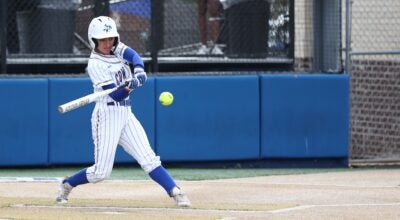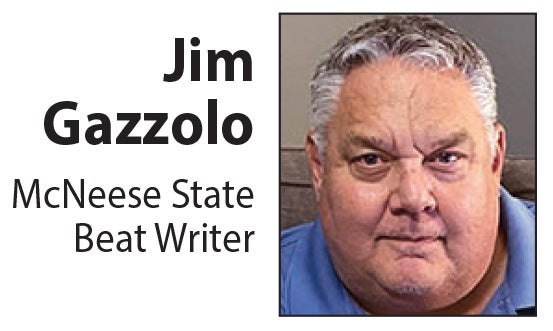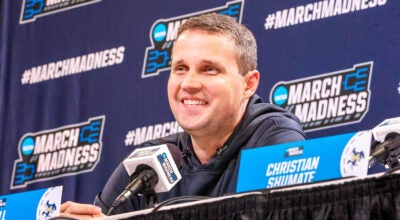Cost of staying competitive high for McNeese
Published 8:43 am Monday, July 1, 2013
When defensive coordinator Mike Collins departed McNeese State for the same position at conference rival Sam Houston State in May — a seemingly lateral coaching move — it raised questions about McNeese’s ability to compete with the pocket book.
If McNeese cannot contend financially amongst its direct peers, how can it be expected to do so on the playing field?
That is the dilemma facing Athletic Director Tommy McClelland, who must try to field competitive programs despite a widening economic gap between McNeese and its Texas rivals in the Southland Conference.
Making ends meet
“We’re all doing everything we can to make it successful,” McClelland said. “We feel supported, don’t get me wrong. But how can we increase it? How can we get even more people involved? I have to ask myself, ‘Can I work harder, be smarter and more efficient with how we operate?’”
Figures released by USA Today earlier this year indicated McNeese ranked seventh in revenue among the eight football-playing schools in the SLC in 2012, bringing in $9,745,534. Only Nicholls State was lower with $7,367,989 in revenue.
Lamar produced the most money of any Southland program ($14,390,054).
The Southland’s two other football-playing schools in Texas, Sam Houston State and Stephen F. Austin, are almost $2 million ahead of the closest Louisiana school, Northwestern State, which generated $11,078,472 in 2012.
Those numbers manifest themselves most clearly in a school’s ability to pay its coaches. McNeese also ranks seventh in that category, with a budget of $2,546,041 for coaches and athletic administrators.
“For us, it’s definitely a challenge,” McClelland said. “We want to retain and attract good coaches equally as well.”
McClelland said he has not been able to raise the base salary of any of his coaches with state money since 2008. Instead, he must rely on outside funding sources to boost their pay via the McNeese Athletic Foundation.
“Our football program, as well as men’s and women’s basketball, have seen those increases based on their championship experiences and what they’ve brought in,” McClelland said. “We’ve been able to increase (salaries) and compensate them, but with private funds.”
Loyal coaches
Of course, money doesn’t always mean everything. Stephen F. Austin has the largest coaching budget in the league at $4.5 million, but McNeese was still able to lure Lance Guidry from SFA to replace Collins as defensive coordinator.
Guidry, a McNeese graduate, is not unlike many of his colleagues — blue-and-gold sometimes means more than green. As he said upon accepting the position, “When momma calls you to come back home, you go.”
That kind of attitude is what McClelland must bank on when he can’t break the bank.
“I can’t control the weather, and I sure the heck can’t control the state of Texas. What we have at McNeese, and I mean this generally, is coaches that want to be here,” McClelland said. “We wish we could pay them a little more. But we have people that have a passion and understand the Cowboy way.”
Finding revenue
Though McNeese’s revenues have increased by approximately 22 percent since 2008, so have its expenses.
“The No. 1 imporant thing for us right now is, ‘How do we increase revenue?’ We’ve increased exponentially since 2008, but we’ve been cut the same. So we have this falling floor and a rising ceiling that have filled each other’s gaps,” explained McClelland. “As public funding continues to dwindle, the interested stakeholders’ stake has got to increase. If there was stability in the economy in terms of gas prices and travel expenses (it wouldn’t be an issue) … we’ve got to make compelling arguments for those things to be invested in.”
A potentially undertapped resource of funding is the student body.
No athletic department in the Southland is more self-sustained than McNeese’s, which gets 47 percent of its funding subsidized by the university and student fees.
In contrast, a whopping 81 percent of SFA’s funds come from subsidies. Lamar and SFA’s dollar amount from subsidies alone exceeds McNeese’s entire budget.
Percentage-wise, the closest Southland schools to McNeese are Southeastern Lousiana and Northwestern State, both of which have 65 percent of their budgets subsidized.
“That’s a compliment to the support that we have in terms of ticket sales, private donations and sponsorships,” McClelland said. “If it wasn’t for that support, the percentage of subsidies would be greater and the total revenue number would be a whole lot less.”
Student factor
Logically, McClelland knows the students are the next place to turn to keep up with the Joneses.
“It’s not just the community person who buys the tickets, but that’s potentially the students at McNeese. They currently have a fee, but is there any appetite for an increase? I can’t make that decision,” McClelland said. “What is important to them? Having an NCAA playoff program? Winning programs? Is that important to the campus community and external community? If so, increasing your participation is an integral part of that.”
With tuition increasing and many college students already living on a pizza-to-pizza budget, asking them to part with more money seems like it would have the odds of a duck on the first day of hunting season.
Students’ point of view
“I think the atmosphere at first would be very negative,” said senior Davante Lewis, who served as president of the McNeese Student Government Association during the spring semester. “But I think in the case of athletics, students would talk. There is so much in the atmosphere that can change.”
Students pay a $32 athletic fee per semester, and recently had a $75 per-semester fee tacked on for a new multi-level student parking garage that opened this spring. Lewis said the parking garage fee is expected to last another 20 years, which doesn’t figure to help the popularity of any proposed increase in the athletics fee.
However, Lewis said he thinks the student body would be amenable to the idea if there is a definitive return on the investment.
“It would take three things to determine student input,” Lewis said. “One is, What is the justification for the increase? Showing those numbers would be great, but they would have to go into more detail about why it puts McNeese at a disadvantage.
“Second is, What could the increased fees do? Would it fund more scholarships, allow them to buy better equpiment?
“Third, and most important, is stressing what the investment means to students. Frankly, LSU probably wouldn’t be the (flagship) school of Louisiana if not for its athletic program and the attention it brings. … You would have to show the students they are gaining something, not losing 20 additional dollars a semester, or whatever the amount may be.”
Vicious cycle
For McNeese, it remains a classic chicken-and-egg scenario. You need money to win, but first you need to win in order to convince people to part with their money.
“Is there a very good correlation between championships and funding? Absolutely,” McClelland said. “But the championships still have to be won. It certainly is my job, and our staff’s job, to relay to the community, where we need their help and recognize there is a big discrepancy between the teams we compete against on a daily basis in our league.”
(American Press Archives)





